Cuba is a country like no other: visitors here experience the thrill of novelty, of being in unfamiliar territory. There is much to see and do, particularly if you enjoy Havana's majestically decaying colonial architecture and revolutionary artefacts infused with communist iconography. Cuba is a vibrant, fun and unique holiday destination and just wandering around the streets or along the beaches is entertainment enough for most visitors. There are, however, plenty of cultural and historical attractions for those who enjoy more traditional sightseeing, including the Museo de la Revolucion, the Capitolio Nacional, and the Museo Nacional de Bellas Artes.Then there are the fabulous beaches, mercifully largely free of the rampant resort development you'll find elsewhere in the Caribbean. And the beaches are not the only natural wonders. It is a pity that many visitors never get out of the capital because the countryside holds a wealth of natural splendour and interesting attractions, such as the sugarcane palaces of Trinidad and the colonial city of Sancti Spiritus. Cuba is also developing its potential for eco-tourism with environmentally stunning areas like the Montemar Natural Park which includes forests, marshes and beautiful clear lagoons. The cave systems of Gran Caverna de Santo Tomas are also pleasantly unspoiled, allowing for a more authentic caving experience than many of the glitzy tourist-orientated caves found on the international circuit.
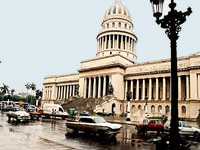
One of Havana's grandest pieces of architecture, the Capitolio is an important landmark and one of Centro Habana's major touristic sights. It was designed to resemble the US Capitol in Washington DC, and the similarity is obvious. A monumental stone stairway leads to the vast domed hall, from where tours will take visitors beyond the doors to elaborately decorated chambers that once housed the seat of Cuban Congress.Today, it is home to the National Library and Academy of Sciences, and many of its rooms are still used for state events. It also houses a planetarium and a museum. Directly beneath the dome lies an imitation 24-carat diamond set into the marble floor, from where all highway distances between Havana and all sites in Cuba are measured.The building is today a bit rundown and the inside is often closed for renovations. Even so the outside makes a great photo spot. The area is a hot spot for vendors, artists and beggars which can make it interesting but be sure to watch your belongings carefully.
Address : Paseo de Marti, Centro Habana
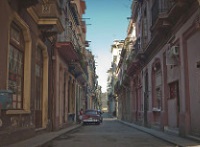
A five-mile (8km) esplanade, roadway and seawall, running between the harbour in Old Havana and the historically Russian area of Vedado, a stroll along El Malécon is the perfect way to start any Havana adventure.The two-hour walk, described by many as a cross-section of Cuba's history, begins in Habana Vieja, where the buildings have had their famous pastel colours faded by the sun and the salty sea-wind, and goes past various monuments to significant figures in Cuba's struggle history (including Máximo Gomez and Calixto García), before ending up in the area of Verdado, a funky downtown district with great sights and vibrant nightlife.Walking El Malecon one bears witness to the strange disparity in Cuba between the wealthy tourist hotels and the rundown local joints. Construction of the walkway began in 1901 and its main purpose was to protect the city from the sea but today it is a very popular social haunt.It is very different to do the walk during the day and at night; perhaps the best way is to begin in the afternoon sun so that you can see the colours of the city, and finish in the evening when the lights come on.
Address : Between the harbour and Vedado, Havana
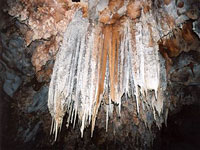
Cuba's largest cave system, with more than 29 miles (46km) of underground galleries spanning eight different levels, the Santo Tomás caves are situated about 10 miles (16km) west of Vinales.Very informative, 90-minute guided tours take visitors 138 feet (42m) above the valley floor into the sixth gallery, where fantastic limestone formations, glittering stalactites and stalagmites, underground lakes and vast caverns are revealed by the light of headlamps. You may be taken to level seven as well but unless you are an advanced caver you will most likely be limited to these two levels; the entrances to levels six and seven are semi-hidden on a forested slope overlooking the valley and they provide wonderful vantage points for views and photographs.The cave system includes a tiny museum and visitor centre but for the most part the caves have been kept in their natural state, avoiding the tourist traps of electrical lighting and souvenir stands. In accordance with this lack of commercialisation, the place is refreshingly devoid of large crowds and tour groups which allows for a more mysterious and authentic tour than is usually possible in famous cave systems.
Address : El Moncada, 11 miles (17km) west of Vinales village
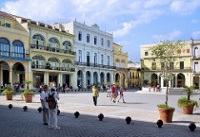
Old Havana (Habana Vieja) is a very special area in Cuba which delights travellers and locals alike. This historic section of Cuba's capital was founded in 1519 and for centuries was an important naval port of colonial Spain. Being in such a strategic position, the city was targeted by pirates and fought over on numerous occasions, and the ruins of the defensive walls that surrounded the city can still be seen.During the years of Prohibition in the United States, Habana Vieja turned into a playground for Americans who flocked here for the cheap liquor, gambling, prostitution and hedonistic lifestyle. One of the district's most famous bars is La Bodeguita Del Medio, which was the favoured haunt of legendary US writer, Ernest Hemingway.The Old City now also contains museums, hotels, restaurants and shops lining the original cobble-stoned streets. Surrounding the picturesque squares (plazas) are beautiful restored colonial buildings with grand facades, and striking churches that form a magnificent setting for the late afternoon chess and domino games and salsa music. The Plaza de Armas was the seat of power in Cuba for 400 years, being the base of operations for the Spanish Captain's General, US military governors and the Cuban president, and today is home to an interesting book market, among other things.
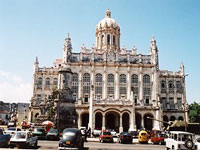
Formerly the Presidential Palace and headquarters of the Cuban government, this impressive building now houses documents, photographs and artefacts pertaining to the Cuban Revolution. The museum provides an excellent introduction to Cuba's historical struggle for independence - there are even blood-stained and bullet-riddled uniforms on display!Prepare to spend a few hours wandering from room to room as the story unfolds, from Spanish colonial times to the present day. In front of the museum entrance stands a watchtower that was part of the old city walls, as well as a tank used by Fidel Castro during the battle of the Bay of Pigs in 1961. Behind the museum is the glass-encased yacht, the 'Granma', which brought 82 revolutionaries, including Che Guevara and Fidel Castro, from Mexico to set the 1956 Revolution in motion.The anti-imperialist tone of the museum will delight some and possibly upset others but for history buffs and those interested in the revolution this museum is a treasure trove. Make sure to get the correct change at the museum counter as there have been reports of minor money scams.
Address : Calle Refugio, between Calle Agramonte and Av de las Misiones, Centro Habana
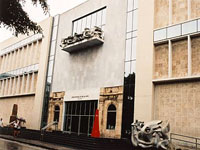
The Bellas Artes Museum was founded in 1913 and is now split into two buildings, both architecturally interesting and impressive, housing International and Cuban art respectively. Both fine art collections are worthy of detailed exploration and should delight any visitor interested in art.The Colección de Arte Universal covers everything from ancient Greek artefacts and Latin American pieces to art by French, Dutch and Italian painters, and includes work by masters such as Gainsborough, Goya and Rubens. The Colección de Arte Cubano is also outstanding and covers works from the 16th to the 20th centuries by prominent Cuban artists.The Cuban galleries have rooms dedicated to religion, landscape, portraits and scenes from Cuban life. Of course, the hyperrealism of the revolution and post-revolution years is also prominent and this has probably become the style of art most associated with modern Cuba. Famous paintings in the contemporary section include Gitana Tropical by Victor Manuel Garcia (the 'Cuban Mona Lisa') and El Rapto de las Mulatas by Carlos Enriquez.
Address : Corner of Calle Trocadero (between Calles Zulueta and Monserrate) and Calle San Rafael (between Calles Zulueta and Monserrate)
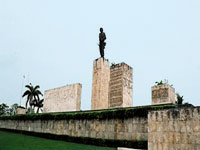
Located 55 miles (88km) north of Trinidad, the city of Santa Clara is best known for its Che Memorial at the Plaza de la Revolución, and monuments relating to the Cuban Revolution. The armoured train monument (Monumento a la Toma del Tren Blindado) marks the spot where Che attacked the train, sending Batista's troops to Santiago de Cuba, a battle which was a decisive factor in the victory of the revolutionaries.The Ernesto Che Guevara Monument was built to pay homage to the memory of Che and his comrades who fought with him in Bolivia, and the enormous monument incorporates a huge statue of Che with his famous phrase Hasta la Victoria Siempre(Forever Onwards Towards Victory), as well as representations of many aspects of his revolutionary life.To one side of the statue, a huge stone block has been inscribed in full with his farewell letter to Fidel Castro. The monument also includes a mausoleum where the remains of Che and his comrades have been interred, and a museum with displays about his life and involvement in the revolution.
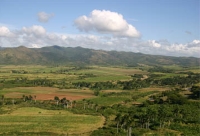
This picturesque emerald valley was once the centre of the sugar trade industry in Cuba, and home to the plantations that brought wealth and prosperity to Trinidad in the 18th and 19th centuries. At the peak of the sugar trade there were over 70 sugar cane mills in the valley area and about 30,000 slaves working on the plantations.Today, the ruins of estates, sugar mills and other remnants are visited by tourists who are attracted by the beauty of the valley and the historical significance of the slave trade that operated during the valley's boom years. The main site is the Manaca Iznaga, a striking 144ft (44m) high tower that was used by a plantation owner, one of the wealthiest men in Cuba, Pedro Iznaga, to keep watch over his slaves working in the fields. The bells in this tower would toll to signal the end of the working day. Visitors can climb the tower for impressive views over the countryside.Along with Trinidad, the Valle de los Ingenios has been declared a UNESCO World Heritage Site. Horse riding tours to the valley, departing from Trinidad, are a popular way to see the sights and take in the beautiful surroundings.
Address : Carretera de Sancti Spiritus (8km from Trinidad)
With 22 miles (36km) of sandy, white, palm-fringed beach, Varadero Beach has often been referred to as one of the world's most beautiful. The incredibly clear water makes for amazing diving, fishing and snorkelling opportunities, and children splashing around will even be able to spot some fantastic fish with the naked eye. Glass-bottomed boat companies abound here too. Varadero Beach is a wonderful place to spend the day and an absolute must-visit while in Cuba.Varadero is situated on a spit of land that reaches out into the Atlantic, a two-hour drive to the east of Havana. There are 23 world-renowned dive spots along this stretch of beach and dive centres providing lessons and equipment. There is also deep sea fishing, windsurfing, parasailing, kayaking and sailing to be enjoyed. Outside of the water there are also numerous restaurants, cabaret spots, nightclubs, land sport opportunities, a skydiving centre, golf courses, and much more.The hotels in Varadero, Cuba's most popular beach resort, are some of the best in the Caribbean. Al Capone used to make this his holiday hideaway when taking a break from racketeering in Chicago. There are a number of big shopping complexes and artisan markets that sell a wide variety of souvenirs. There are also many bars and restaurants in Varadero, and it isn't hard to find live music.Whether you are visiting for a day on the beach, or staying at the resort for a holiday, Varadero is unmatched in Cuba for its natural beauty and its touristic facilities.

Travel Guide powered by Word Travels, copyright © 2023 Globe Media Ltd. By its very nature information in this travel guide is subject to change at short notice and travellers are urged to verify information on which they're relying with the relevant authorities. Neither Globe Media Ltd nor Travel Vogue can accept any responsibility for any loss or inconvenience to any person as a result of information contained above.